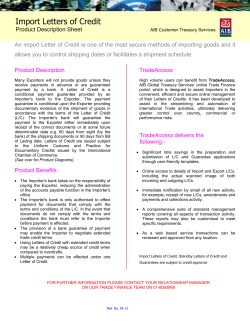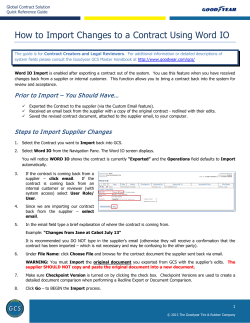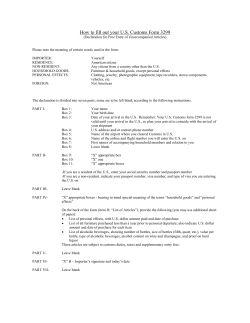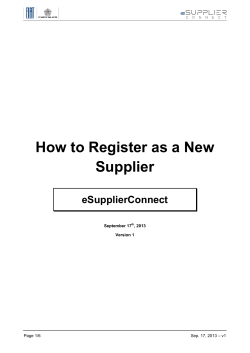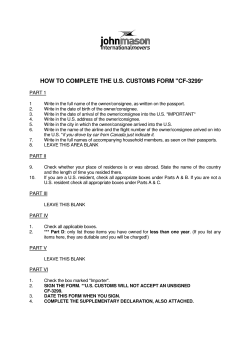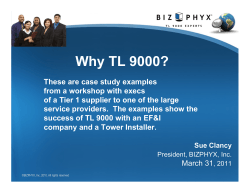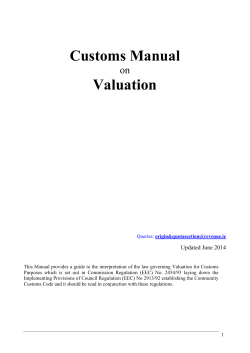
CUSTOMS EXTERNAL COMPLETION MANUAL
Effective 24 January 2014 CUSTOMS EXTERNAL COMPLETION MANUAL DA 55 Effective 24 January 2014 TABLE OF CONTENTS 1 2 3 3.1 3.2 3.3 3.4 3.5 3.6 3.7 3.8 3.9 3.10 4 4.1 4.2 4.3 5 6 SCOPE REQUIREMENTS FOR A DA 55 COMPLETION OF THE DA 55 – VALUATION QUESTIONNAIRE Details of importer Details of supplier Details of goods Completion notes Details regarding the purchase of the imported goods Details on limitations Details on the ordering process Details regarding royalties or license fees Details on assist Declaration REFERENCES Legislation Cross References Quality Records DEFINITIONS AND ACRONYMS DOCUMENT MANAGEMENT Completion of DA 55 – External Manual SC-CR-A-13 Revision: 2 3 3 3 3 3 3 4 4 4 5 5 5 6 6 6 7 7 7 7 Page 2 of 7 Effective 24 January 2014 1 SCOPE a) This document will assist clients with the accurate completion of the DA 55, in order to minimise the rejection rate due to the incorrect completion of the form and to maintain uniformity and consistency. b) All applications for value determinations and value enquires must be accompanied by a completed DA 55 commonly referred to as a “Valuation Questionnaire”, and submitted together with the supporting documents in terms of Rule 65.01. 2 REQUIREMENTS FOR A DA 55 a) The DA 55 – i) ii) iii) iv) v) vi) Consists of two (2) pages; Must be attached so that the page numbers follow in sequence; Must have dimensions of 420 mm x 297 mm; Must be printed upright; Must be printed in black ink on white paper with a mass of not less than 80 g/m²; Must be original. b) Information entered on the DA 55 must be typed or printed in block letters and must be legible. c) Supporting documents accompanying the submission must be clearly marked. 3 COMPLETION OF THE DA 55 – VALUATION QUESTIONNAIRE 3.1 Details of importer FIELD DESCRIPTION Importer Name Customs Client Number Importer Address EXPLANATION The name of the importer must be entered in this field and must be identical to the name reflected on the commercial invoice and import declaration form. It must also agree with the particulars submitted with the application for a Customs client number. The Customs client number allocated to the licensed importer must be inserted in this field. Both the physical street address and postal address of the importer must be entered in this field. It must also agree with the particulars submitted with the application for a Customs client number. 3.2 Details of supplier FIELD DESCRIPTION Supplier Name Supplier Address EXPLANATION The name of the importer must be entered in this field and must be identical to the name reflected on the commercial invoice. The physical street address of the supplier must be entered in this field and must be identical to the address reflected on the commercial invoice and import declaration form. The physical street address of the supplier should include the city’s name, for example, ABC Manufacturer, Dublin, Ireland. 3.3 Details of goods FIELD DESCRIPTION Description of Goods EXPLANATION A general description of the imported goods is required and need not be exactly the same description as reflected on the seller’s commercial invoice i.e. chemicals, motor vehicles, etc. If more than one (1) commodity is imported from the supplier, this should also be declared i.e. chemicals, clothing and cell phones. Completion of DA 55 – External Manual SC-CR-A-13 Revision: 2 Page 3 of 7 Effective 24 January 2014 3.4 Completion notes FIELD DESCRIPTION Notes EXPLANATION a) Wherever a “yes” or “no” answer is required, the appropriate block must be indicated by an “X”. b) Wherever details are required and the space provided is insufficient, annexes may be used and reference made to the annex on the questionnaire. c) Wherever a question is posed and the words “you” or “your” are used, it refers to the importer or his/her duly authorised representative. 3.5 Details regarding the purchase of the imported goods FIELD DESCRIPTION The Goods acquired through outright purchase? If “yes” state terms of sale If “no” state basis of acquisition (e.g. lease, hire, etc.) and terms EXPLANATION A “yes” or “no” answer is required; the appropriate block must be indicated by an “X”. The “terms of sale” referred to in this field is the Incoterms 2000, for example, FOB, etc. In no sale situations (hire, lease, on consignment goods, etc.) the importer and supplier are the same legal entity. Also goods which were received at no charge or free of charge goods to cover a warranty agreement. Examples of such goods include: a) Free consignments like gifts, samples, promotional items, etc. b) Goods imported on consignment or stock. c) Goods imported by intermediaries, who do not purchase the goods and who sell them after importation. d) Goods imported by branches of the supplier, which are not separate legal entities. e) Goods imported under a hire or lease agreement. f) Goods supplied on loan, which remains the property of the sender. g) Goods (waste or scrap) imported for destruction in the country of importation, with the sender paying the importer for the services. 3.6 Details on limitations FIELD DESCRIPTION Has the supplier imposed any restriction regarding the disposal, use or subsequent resale of the imported goods which substantially influence the price to you? (Territorial restriction excluded) Is the sale or price subject to some other condition or consideration for which a value cannot be determined? Does any part of the proceeds of subsequent resale, disposal or use of the imported goods accrue directly or indirectly to the supplier? (Royalties, License Fees and Dividends excluded) EXPLANATION Any restriction imposed by the supplier of the goods on the importer must be declared here, except territorial restrictions. A “yes” or “no” answer is required; the appropriate block must be indicated by an “X”. If “yes”, give details, including extent of the influence on the price. Any condition or consideration to which the sale or price of the goods are subjected to, for which a value cannot be determined, with respect to the goods being valued, should be declared here. A “yes” or “no” answer is required; the appropriate block must be indicated by an “X”. If “yes”, give details. Any amount or goods accruing back to the supplier must be declared here, excluding payments made in lieu of royalties, license fees and dividends. A “yes” or “no” answer is required and the appropriate block must be indicated by an “X”. If “yes”, give details of the arrangements with the supplier and attach a copy of any agreement the client may have with him/her in this regard. Completion of DA 55 – External Manual SC-CR-A-13 Revision: 2 Page 4 of 7 Effective 24 January 2014 FIELD DESCRIPTION Are you related to the supplier within the meaning of Section 66(2)(a) of the Customs and Excise Act? EXPLANATION Any relationship between the importer and supplier must be declared here. A “yes” or “no” answer is required and the appropriate block must be indicated by an “X”. If “yes”, give details and state to what extent the relationship influences the price. If “yes” and the client claims that the relationship has not influenced the price, evidence that the supplier’s price to the importer is acceptable as open market prices or approximates the price of identical or similar goods sold to unrelated importers in South Africa must be furnished. 3.7 Details on the ordering process FIELD DESCRIPTION Are your orders on the supplier placed through a selling (indent) agent? If “yes”, is the agent’s commission included in the supplier’s selling price? If the answer to the previous question is “NO”, how is the commission paid? EXPLANATION This question is raised to verify whether there is a third party or middleman involved in the sales transaction and for whose benefit he/she is acting. . A “yes” or “no” answer is required and the appropriate block must be indicated by an “X”. A “yes” or “no” answer is required and the appropriate block must be indicated by an “X”. The client should elaborate on how commission was invoiced and paid. If the importer is paying commission to his/her middleman or agent this must be declared here. 3.8 Details regarding royalties or license fees FIELD DESCRIPTION Are royalties or license fees related to the imported goods payable by you as a condition of sale? EXPLANATION Any royalty or license fee payable by the importer must be declared in this field. A “yes” or “no” answer is required and the appropriate block must be indicated by an “X”. a) If “yes”, give details, including a copy of the client’s agreement and where, possible the amount payable expressed as a percentage of the FOB value of the imported goods. b) If “no” and the client claims that the royalty is not payable to the supplier of the goods but to a third party or as a condition of sale, evidence of this must be attached. 3.9 Details on assist FIELD DESCRIPTION Do you supply any of the following goods or services free of charge or at a reduced cost to your supplier for use in the production, and sale to you, of the imported goods? Materials, components, parts and similar items incorporated in Tools, dies, moulds and similar items used in the production of the imported goods EXPLANATION It is not uncommon for an importer to furnish his/her supplier or manufacturer with assistance in one (1) form or another and is known as “assists”, derived from assistance. The items detailed in Section 67(1)(b) are in addition to charges commonly shown on an invoice. In many cases the additional costs will be includable in the Customs value of the imported goods. The list of “assists” covers four (4) categories of goods and services, which is covered in the next four (4) questions. Give details in respect of all the “yes” answers in the following fields. These are tangible items which physically exist in the imported product and the value to be added to the price paid or payable in determining the Customs value is the cost to the importer or manufacturing or otherwise acquiring it. Where, for example, a certain amount of waste occurs in the manufacture of the product to be exported to South Africa, no allowance can be made in respect of that waste. A “yes” or “no” answer is required and the appropriate block must be indicated by an “X”. These items are production equipment provided by the importer in order to facilitate the manufacture or the imported goods. Determining the amount to be added to the price paid or payable may prove to be difficult because it will depend on factors which will be difficult to quantify accurately. A “yes” or “no” answer is required and the appropriate block must be indicated by an “X”. Completion of DA 55 – External Manual SC-CR-A-13 Revision: 2 Page 5 of 7 Effective 24 January 2014 FIELD DESCRIPTION Materials consumed in the production of the imported goods, but not incorporated therein Engineering, development, artwork, design work and plans and sketches undertaken outside the Republic and necessary for production of the imported goods EXPLANATION This will include catalysts, lubricants, abrasives and similar materials which do not become part of the imported goods, but are necessary in the manufacture thereof. The value of an “assist” in this category is the cost thereof to the importer of producing, or otherwise acquiring, it. In determining the value, no allowance can be made for waste. A “yes” or “no” answer is required and the appropriate block must be indicated by an “X”. When engineering, development, artwork, design or plans and sketches carried out outside South Africa are provided by or on behalf of the importer, free or at a reduced cost, their value is to be included in the Customs value of the imported goods if not yet included in the price actually paid pr payable. The value of an “assist” in this category is the cost thereof to the importer of producing, or otherwise acquiring, it. A “yes” or “no” answer is required and the appropriate block must be indicated by an “X”. 3.10 Declaration FIELD DESCRIPTION I herby declare that the details contained in this questionnaire are true and correct and that no information has been withheld Signature Name in print Designation Date 4 EXPLANATION The declaration field of a document is very important as it gives the document legal status. a) The DA 55 can be signed by any person: i) Residing or having a place of business in South Africa, or ii) Who is knowledgeable about the business and has the information needed to answer the questions on the form. b) Where the form is completed for a company, the person signing can be a responsible representative of the company, such as a director, owner, company secretary or manager. c) One (1) of the above-named persons may authorise an employee, in writing, to sign on behalf of the company. A copy of this authorisation must be attached to the DA 55. d) Clearing agents may sign the form on behalf of the importer when authorised to do so in writing and a copy of the authorisation must be attached to the DA 55. e) The person signing the declaration is responsible for the accuracy and completeness of the facts given on the form. The full name and not only initials of the person who completed and signed the DA 55 must be legibly printed in this field. The designation of the person, in relation to the company he/she represents, who completed the DA 55, must be inserted in this field. This is the date on which the DA 55 is completed and the declaration is made by the client. The date particulars must be entered here in century; year; month and day sequence, e.g. 2007.10.12. REFERENCES 4.1 Legislation TYPE OF REFERENCE REFERENCE Legislation and Rules Customs and Excise Act No. 91 of 1964: Sections 39A, 41, 65, 66, 67, 71 , 72, administered by SARS: 74 and 74A Customs and Excise Rules: Rule 39.04, 41.01, 41.02, 41.03, 41.04, 41.05, 65.01, 65.02, 65.03, 66.01, 66.02, 66.03, 66.04 and 66.05 Harmonised Tariff System: Schedule 1 part 2B Value-Added Tax Act No. 89 of 1991: Section 13(2) Tax Administration Act No. 28 of 2011: Sections 215 to 220 and 224 Completion of DA 55 – External Manual SC-CR-A-13 Revision: 2 Page 6 of 7 Effective 24 January 2014 TYPE OF REFERENCE Other Legislation: International Instruments: REFERENCE Merchant Shipping Act of 1951: All Promotion Of Access To Information Act No. 2 of 2000: All Promotion of Administrative Justice Act No. 3 of 2000: Section 3 and 5 Merchant Shipping Act No. 57 of 1951: All Kyoto Convention General Annex Chapter 9 – Information, Decisions and Rulings supplied by Customs: Standards 9.1 to 9.9 WTO Agreement on Implementation of Article VII of the GATT 1994: All 4.2 Cross References DOCUMENT # SC-CR-A-02 SC-CR-A-03 SC-CR-A-04 SC-CR-A-06 4.3 Quality Records NUMBER DA 55 5 TITLE Valuation Questioner DEFINITIONS AND ACRONYMS Act CIF FOB SAD You/Your 6 DOCUMENT TITLE Valuation of Imports – Internal Policy Valuation of Imports – External Directive Method 1 Valuation of Imports – Internal Policy Valuation of Exports – Internal Policy Customs and Excise Act No. 91 of 1964 Cost, Insurance and Freight: This term is a monomodal term and it can only be used for transactions where sea freight is the main carriage and represents the basic conditions of CFR with the addition of insurance. Free on Board: In defining FOB as an Incoterms, it is expressed as being monomodal term and it can only be used for transactions where sea freight is the main carriage. As an Incoterm, there is no application for FOB in road, rail or air transport. Single Administrative Document Wherever a question is pose and the words “you” or “your” are used, it then refers to the importer or his/her duly authorised representative DOCUMENT MANAGEMENT Business Owner Document Owner Author Detail of change from previous revision Template number and revision Group Executive: Customs Operations Executive: Process Solutions Customs & Support Services Y. Els Updating template ECS-TM-16 – Rev 3 Completion of DA 55 – External Manual SC-CR-A-13 Revision: 2 Page 7 of 7
© Copyright 2025
